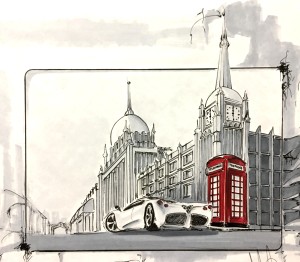
“The Shortest Distance, an accidental series” by Talha Kabasakal has been installed in the A2A Alcove, located on the upper mezzanine of the William R. Jenkins Architecture and Art Library. Talha Kabasakal, a second-year student at the University of Houston, College of Architecture and Design, is majoring in industrial design and pursuing his goal of becoming a car designer. His series of ink-on-paper works that, in large measure, depict the artist’s life and expectations, referencing his love of cars, his preferred color red, and his native Turkey. In one particular piece Talha has played upon the notion of a personal geographic dichotomy by juxtaposing two places, two different countries – the familiar and the foreign, the old and the new, the past and the future. Though each occupies discrete areas, isolated at opposite sides of the composition, the two are connected by a bridge. Talha believes that there should always be a bridge, a connection. That bridge could represent hope, remembrance, love…
The library supports UH student artists by hosting exhibitions of their work throughout the year. All displayed works are digitally documented and included in the UH Digital Library. You’re cordially invited to stop by the William R. Jenkins Architecture and Art Library for a look at The Shortest Distance, on display through April.
Die renaissance in Italien. Eine sammlung der werthvollsten erhaltenen monumente in chronologischer folge geordnet. Früh renaissance: http://digital.lib.uh.edu/collection/frare/item/6209
Die renaissance in Italien. Eine sammlung der werthvollsten erhaltenen monumente in chronologischer folge geordnet. Hoch renaissance: http://digital.lib.uh.edu/collection/frare/item/6571
Die renaissance in Italien. Eine sammlung der werthvollsten erhaltenen monumente in chronologischer folge geordnet. Decoration in stein und terra cotta: http://digital.lib.uh.edu/collection/frare/item/6419
Die renaissance in Italien. Eine sammlung der werthvollsten erhaltenen monumente in chronologischer folge geordnet. Decoration in holz: http://digital.lib.uh.edu/collection/frare/item/6015
The Jenkins Library Ambassadors are student leaders who serve as the library’s advisory board and who help their fellow students learn about research tools and services. We are actively recruiting new members. A lunchtime meeting will be held at noon in room 215 of the College of Architecture. Pizza will be served.
Three new oral histories have been added to Building Houston, a digital collection of interviews with people who strongly impacted Houston’s built environment, which is co-sponsored by the William R. Jenkins Architecture and Art Library and the Houston Chapter of the American Institute of Architects.
UH alumnus David Bucek interviews Raymond Brochstein, FAIA, whose company Brochsteins, Inc. has supplied custom architectural woodwork and furniture to notable buildings designed by Richard Meier, Philip Johnson, SOM, Gensler, and many others. Mr. Brochstein and his wife, Susan, are also notable philanthropists, who have helped develop Houston’s green spaces and who donated the Brochstein Pavilion to Rice University in 2010.
Joe Mashburn, FAIA, Dean of the UH College of Architecture from 1998-2009, discusses his career as an architect and educator with architectural historian Anna Mod. He also addresses key moments in the history of the College of Architecture. As a student in the late 1960’s, he studied with Doug Michels and Chip Lord and witnessed protests over the college leadership.
John Paukune was an unemployed architect just out of school when he walked onto the construction site of the Astrodome and was hired to help oversee its completion. He discusses the politics, innovations, and problems behind the building of Houston’s most iconic structure with architect Kerry Goelzer, as well as his post-Astrodome career.
